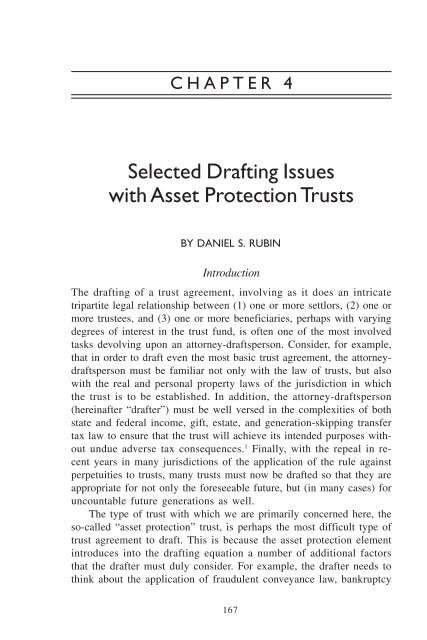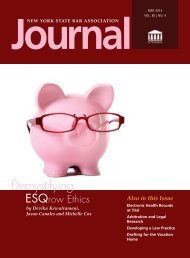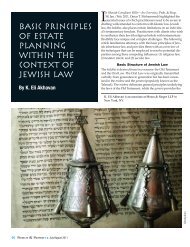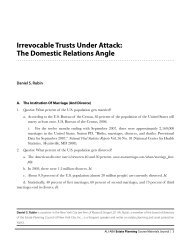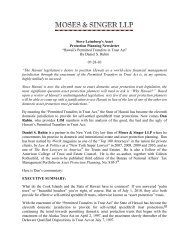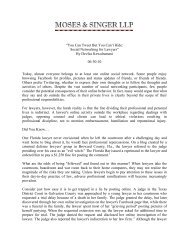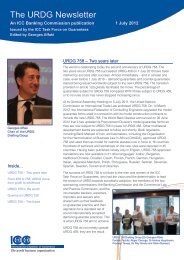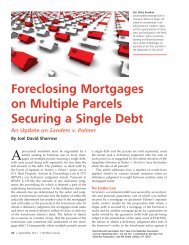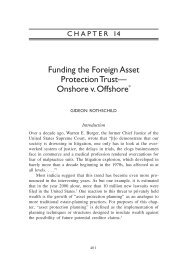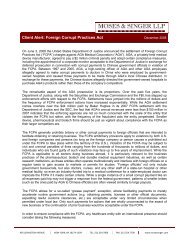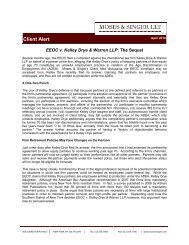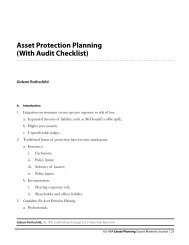Asset Protection Strategies - Moses & Singer, LLP
Asset Protection Strategies - Moses & Singer, LLP
Asset Protection Strategies - Moses & Singer, LLP
You also want an ePaper? Increase the reach of your titles
YUMPU automatically turns print PDFs into web optimized ePapers that Google loves.
CHAPTER 4<br />
Selected Drafting Issues<br />
with <strong>Asset</strong> <strong>Protection</strong> Trusts<br />
BY DANIEL S. RUBIN<br />
Introduction<br />
The drafting of a trust agreement, involving as it does an intricate<br />
tripartite legal relationship between (1) one or more settlors, (2) one or<br />
more trustees, and (3) one or more beneficiaries, perhaps with varying<br />
degrees of interest in the trust fund, is often one of the most involved<br />
tasks devolving upon an attorney-draftsperson. Consider, for example,<br />
that in order to draft even the most basic trust agreement, the attorneydraftsperson<br />
must be familiar not only with the law of trusts, but also<br />
with the real and personal property laws of the jurisdiction in which<br />
the trust is to be established. In addition, the attorney-draftsperson<br />
(hereinafter “drafter”) must be well versed in the complexities of both<br />
state and federal income, gift, estate, and generation-skipping transfer<br />
tax law to ensure that the trust will achieve its intended purposes without<br />
undue adverse tax consequences. 1 Finally, with the repeal in recent<br />
years in many jurisdictions of the application of the rule against<br />
perpetuities to trusts, many trusts must now be drafted so that they are<br />
appropriate for not only the foreseeable future, but (in many cases) for<br />
uncountable future generations as well.<br />
The type of trust with which we are primarily concerned here, the<br />
so-called “asset protection” trust, is perhaps the most difficult type of<br />
trust agreement to draft. This is because the asset protection element<br />
introduces into the drafting equation a number of additional factors<br />
that the drafter must duly consider. For example, the drafter needs to<br />
think about the application of fraudulent conveyance law, bankruptcy<br />
167
168 CHAPTER FOUR<br />
law, banking law, and certain aspects of the criminal law. Moreover, in<br />
most cases the drafter must also consider the conflict of law rules applicable<br />
to both the jurisdiction that would serve as the likely forum<br />
for any future litigation against the trust, as well as the conflict of law<br />
rules applicable to the jurisdiction whose law is designated under the<br />
trust agreement as the trust’s governing law. Finally, if the trust to be<br />
drafted is to be an “offshore” or “foreign” asset protection trust, 2 all of<br />
these areas of concern are multiplied by a factor of two or more since<br />
the drafter must then consider and plan not only for local law considerations,<br />
but for foreign law considerations as well.<br />
A number of the drafting issues applicable to asset protection trusts<br />
are, for various reasons, particularly notable and warrant an in-depth<br />
analysis. They include, but are certainly not limited to, (1) drafting for<br />
a so-called “hybrid” foreign trust (defined below) for United States<br />
tax purposes, (2) drafting for the possibility of duress being exerted<br />
against the trust settlor, trust protector 3 or trustee, and (3) drafting in<br />
consideration of United States gift, estate, and generation-skipping<br />
transfer taxation. This chapter will explore each of these drafting issues<br />
in detail and, where appropriate, will provide suggested drafting<br />
language for the drafter’s consideration.<br />
Drafting for a So-called “Hybrid” Foreign Trust<br />
Introduction<br />
For all of the asset protection benefits conferred by offshore asset protection<br />
trusts that are not conferred in equal measure by their newer<br />
domestic counterparts 4 (a comparison of which is beyond the scope of<br />
this chapter), one negative side effect of the “foreign” status of such<br />
trusts is the administrative burden imposed by the additional tax reporting<br />
required of such trusts, as well as those who transact with, or<br />
are the beneficiaries of, such trusts. 5 Some believe that the administrative<br />
burden of such tax reporting (which at present would require, at a<br />
minimum, the annual filing of a Form 1040NR, U.S. Nonresident Alien<br />
Income Tax Return, a Form 3520, Annual Return to Report Transactions<br />
with Foreign Trusts and Receipt of Certain Foreign Gifts, and a<br />
Form 3520-A, Annual Information Return of Foreign Trust With a U.S.<br />
Owner (Under section 6048(b)), and potentially a Form TD F 90-22.1,<br />
Report of Foreign Bank and Financial Accounts 6 ) to be unduly onerous.<br />
Others might have the additional concern that the settlement of a<br />
foreign trust (or, alternatively, the holding of a beneficial interest in a
Selected Drafting Issues with <strong>Asset</strong> <strong>Protection</strong> Trusts 169<br />
foreign trust) would heighten their visibility before the Internal Revenue<br />
Service and subject them to additional risk of audit. Finally, there<br />
is also the potential for the imposition of a substantial capital gains tax<br />
pursuant to Internal Revenue Code (IRC) section 684 where the foreign<br />
asset protection trust is structured so that the trust would not be<br />
includible in the taxable estate. For some individuals, these issues would<br />
compel a decision against establishing a foreign asset protection trust,<br />
irrespective of the individual’s perceived creditor risk.<br />
It is, therefore, extremely fortuitous that under the Internal Revenue<br />
Code a “foreign” asset protection trust (or any other trust, for<br />
that matter) is not necessarily a “foreign trust” for United States federal<br />
tax purposes. In point of fact, if it is deemed desirable to do so, an<br />
otherwise “foreign” asset protection trust can, through careful drafting,<br />
be qualified as a “United States person” and, as a consequence,<br />
be deemed a purely “domestic trust” for United States federal tax purposes,<br />
thereby eliminating all of the additional tax reporting requirements<br />
noted above except that a Form 1041, U.S. Income Tax Return<br />
for Estates and Trusts, would be required in lieu of a Form 1040NR,<br />
U.S. Nonresident Alien Income Tax Return. Therefore, a “foreign” asset<br />
protection trust should actually be thought of simply as a trust<br />
whose designated governing law is, for trust law purposes, the law of<br />
some non-U.S. jurisdiction; more specifically, the taxonomy of a trust<br />
as a “foreign” asset protection trust should engender no necessary<br />
inference that the trust is also a “foreign trust” for United States federal<br />
tax purposes.<br />
Definitions<br />
An “offshore” or “foreign” asset protection trust that is drafted so as to<br />
qualify as a “United States person” (and, as a consequence, a “domestic<br />
trust” for United States federal tax purposes) is commonly referred<br />
to as a “hybrid” foreign trust. In order to understand how a hybrid<br />
foreign trust is drafted, however, it is first necessary to understand<br />
what exactly is a “domestic trust” (which term the Treasury Regulations<br />
state means a trust that is a “United States person”) 7 and what<br />
exactly is a “foreign trust” for purposes of the United States federal<br />
tax law. In this regard, we are referred to IRC sections 7701(a)(30)<br />
and (31), which respectively provide definitions of the mutually exclusive<br />
terms “United States person” 8 and “foreign trust.” 9
170 CHAPTER FOUR<br />
As the term “United States person” relates to trusts, it is defined<br />
under IRC section 7701(a)(30)(E) as “any trust if - (i) a court within<br />
the United States is able to exercise primary supervision over the administration<br />
of the trust, and (ii) one or more United States persons<br />
have the authority to control all substantial decisions of the trust.” 10<br />
These two prongs are respectively referred to in the Treasury Regulations<br />
as the “court test” 11 and the “control test,” 12<br />
The term “foreign trust” is defined under IRC section<br />
7701(a)(30)(E) in the Internal Revenue Code’s inimical way as “. . .<br />
any trust other than a trust described in subparagraph (E) of paragraph<br />
(30).” Stated plainly, all trusts are foreign trusts except those that meet<br />
both the court test and the control test.<br />
The “Court Test”<br />
The court test of IRC section 7701(a)(30)(E)(i) will be met if the trust<br />
is under the “primary supervision” of a United States court. 13 This<br />
means that a United States court has or would have the authority to<br />
determine substantially all issues regarding the administration of the<br />
entire trust. 14 As the Treasury Regulations point out, however, this does<br />
not necessarily mean that another court does not have jurisdiction over<br />
a trustee, a beneficiary, or some property of the trust. 15 Moreover, a<br />
trust would still be found in compliance with the court test even if both<br />
a United States court and a foreign court are able to exercise concurrent<br />
primary supervision over the administration of the trust. 16<br />
The phrase “is able to exercise” as used within IRC section<br />
7701(a)(30)(E)(i) means that a court has or would have the authority<br />
under applicable law to render orders or judgments resolving issues<br />
concerning the administration of the trust. 17 The term “administration”<br />
means the carrying out of the duties imposed by the terms of the trust<br />
deed and applicable law, including maintaining the books and records<br />
of the trust, filing tax returns, managing and investing the assets of the<br />
trust, defending suits by creditors, and determining the amount and<br />
timing of distributions. 18<br />
Notably, since the court test looks only to the administration of a<br />
trust and not to the designated governing law of the trust, an asset<br />
protection trust can be drafted for compliance with the court test for<br />
determining whether the trust is a “United States person” for United<br />
States federal tax purposes notwithstanding the fact that the trust agreement<br />
provides for governance of the trust under foreign law. In order<br />
to provide for governance of the trust under the law of some appropri-
Selected Drafting Issues with <strong>Asset</strong> <strong>Protection</strong> Trusts 171<br />
ate foreign jurisdiction (in the example below, the Cook Islands), with<br />
administration reserved to the courts of the United States or a political<br />
subdivision thereof (so as to ensure compliance with the court test),<br />
the drafter might consider using the following language:<br />
The Applicable Law (as defined in Paragraph _____ of<br />
ARTICLE _____) of the Trust shall be the law of the Cook<br />
Islands. Notwithstanding the foregoing, however, as it is<br />
the intent of the Settlor that the Trust not constitute a “foreign<br />
trust” as defined in Section 7701(a)(31)(B) of the Code:<br />
(i) the place of administration of the Trust shall be the state<br />
of residence or domicile of the first such Trustee listed on<br />
Schedule I hereto, 19 provided that in the event such person<br />
no longer serves as a Trustee, the place of administration<br />
shall be the state of residence or domicile of the longest<br />
serving Trustee resident or domiciled in the same country<br />
as a majority of the Beneficiaries; and (ii) with respect to all<br />
matters of administration of the Trust, but only as to matters<br />
of administration, the Applicable Law of the Trust shall be<br />
the laws of the place of administration. As such, primary<br />
supervision of administration shall be in the courts of the<br />
place of administration. Notwithstanding the foregoing,<br />
however, to the extent that the laws regarding administration<br />
of trusts in such place of administration conflict with<br />
the International Trusts Act 1984, as amended from time to<br />
time of the Cook Islands (the “Act”) as it may exist regarding<br />
the administration of trusts, the Act shall override and<br />
govern; and in such case, the courts of such place of administration<br />
shall apply the Act in the supervision of the administration<br />
of the Trust. In furtherance of the foregoing, it is<br />
the intent and purpose of the Settlor that the Trust satisfy<br />
and meet the definition of a “United States person” as that<br />
term is used within Section 7701(a)(30)(E) of the Code. In<br />
furtherance of this intent and purpose, no powers of the<br />
Trustees may be exercised and no provision hereof shall<br />
operate in any manner so as to cause the Trust to fail to so<br />
qualify as a United States person, and to such extent the<br />
respective powers of the Trustees as set forth throughout<br />
the Trust are hereby limited. Further, with respect to future<br />
regulations, rulings or court decisions which may affect the
172 CHAPTER FOUR<br />
evolving definition of a United States person as it applies to<br />
a trust, the Trustees are directed to manage and administer<br />
the Trust Fund in such a manner as to assure continuing<br />
compliance. If meeting the definition aforesaid shall require<br />
the Trustees to sign an agreement, make an election or use<br />
their powers to amend the Trust, they shall do so without<br />
liability. The foregoing provisions of this ARTICLE are subject<br />
always to the Trustees’ power to remove a co-trustee<br />
resident or domiciled in a jurisdiction in which the Trustee<br />
has become subject to the threat of or the actual compulsion<br />
of the Trustee to sell, transfer or otherwise dispose of Trust<br />
Fund assets in a manner inconsistent with the terms and provisions<br />
of this Settlement and subject always to the Trustees’<br />
power to change the Applicable Law of the Trust, with<br />
it being acknowledged that the exercise of such powers may<br />
result in the Trust then meeting the definition of a “foreign<br />
trust” under the Code.<br />
There also exists a regulatory safe harbor under Treas. Reg. section<br />
301.7701-7(c)(1) (with which the foregoing language comports)<br />
which, if met, will ensure qualification of the trust under the court test.<br />
A trust will fall within the regulatory safe harbor for meeting the requirements<br />
of the court test if the following three conditions are met:<br />
1. the trust instrument does not direct that the trust be administered<br />
outside the United States;<br />
2. the trust is, in fact, administered exclusively in the United States;<br />
and<br />
3. the trust does not have an automatic migration provision (also<br />
known as an automatic “flee” clause). 20<br />
With regard to this last point, an automatic migration or “flee”<br />
clause will be deemed to exist if the trust deed provides that an attempt<br />
by a United States court to assert jurisdiction or otherwise to supervise<br />
the administration of the trust, directly or indirectly, would cause the<br />
trust to migrate from the United States (unless limited to the case of<br />
foreign invasion or widespread confiscation or nationalization of property).<br />
21 Obviously, the inclusion a migration or “flee” clause would<br />
not be inappropriate for inclusion within a trust drafted for asset protection<br />
purposes, but for a trust drafted to meet the regulatory safe
Selected Drafting Issues with <strong>Asset</strong> <strong>Protection</strong> Trusts 173<br />
harbor of Treas. Reg. section 301.7701-7(c)(1), such provision would<br />
have to be permissive rather than automatic. For a permissive migration<br />
or “flee” clause that should not cause the trust to fall outside of<br />
the regulatory safe harbor of Treas. Reg. section 301.7701-7(c)(1),<br />
consider using the following language:<br />
The Trustees may, by a written declaration executed by them,<br />
at any time or times and from time to time, during the Trust<br />
Period, as they deem advisable in their discretion for the<br />
benefit or security of the Trust Fund or any portion hereof,<br />
remove (or decline to remove) all or part of the assets and/<br />
or the situs of administration thereof from one jurisdiction<br />
to another jurisdiction and/or declare that this Settlement<br />
shall from the date of such declaration take effect in accordance<br />
with the law of some other state or territory in any<br />
part of the world and thereupon the courts of such other<br />
jurisdiction shall have the power to effectuate the purposes<br />
of this Settlement to such extent. In no event, however, shall<br />
the law of some other state or territory be any place under<br />
the law of which: (1) substantially all of the powers and<br />
provisions herein declared and contained would not be enforceable<br />
or capable of being exercised and so taking effect;<br />
or (2) this Settlement would not be irrevocable. From<br />
the date of such declaration the law of the state or territory<br />
named therein shall be the Applicable Law, but subject always<br />
to the power conferred by this Section _____ of this<br />
ARTICLE _____ and until any further declaration be made<br />
hereunder. So often as any such declaration as aforesaid<br />
shall be made, the Trustees shall be at liberty to make such<br />
consequential alterations or additions in or to the powers,<br />
discretions and provisions of this Settlement as the Trustees<br />
may consider necessary or desirable to ensure that the provisions<br />
of this Settlement shall, mutatis mutandis, be so valid<br />
and effective as they are under the Applicable Law governing<br />
this Settlement at the time the power contained herein is<br />
exercised. The determination of the Trustees as to any such<br />
removal or change in Applicable Law shall be conclusive<br />
and binding on all persons interested or claiming to be interested<br />
in this Settlement, and the written declaration executed<br />
by the Trustees from time to time effecting any such
174 CHAPTER FOUR<br />
change in situs or Applicable Law is hereby deemed to be a<br />
term or provision of this Settlement as if included herein on<br />
the date of execution of this Settlement by the Settlor.<br />
The “Control Test”<br />
The control test of IRC section 7701(a)(30)(E)(ii) will be met if one or<br />
more United States persons have the authority to control all substantial<br />
decisions of the trust. 22 “Control” is defined as having the power,<br />
by vote or otherwise, to make all of the substantial decisions of the<br />
trust, with no other person having the power to veto any of the substantial<br />
decisions. 23 To determine whether United States persons have<br />
control, therefore, it is necessary to consider all persons who have<br />
authority to make a substantial decision of the trust (i.e., such as a trust<br />
protector), and not merely trust fiduciaries such as trustees. 24 Moreover,<br />
the Treasury Regulations provide that a United States person will<br />
not be considered to control all substantial decisions of the trust if an<br />
attempt by any government agency or creditor to collect information<br />
from or assert a claim against the trust would cause one or more substantial<br />
decisions of the trust to no longer be controlled by the United<br />
States person, for example, by reason of the operation of an automatic<br />
migration provision. 25<br />
“Substantial decisions” are defined under the Treasury Regulations<br />
as those decisions that persons are authorized or required to make<br />
under the terms of the trust instrument and applicable law, and that are<br />
not merely ministerial. 26 The Treasury Regulations note several decisions<br />
that are merely “ministerial,” including decisions regarding details<br />
such as the bookkeeping, the collection of rents, and the execution<br />
of investment decisions relating to the trust. 27 Other decisions, which<br />
the Treasury Regulations regard as a nonexclusive list of “substantial<br />
decisions,” include those made with respect to:<br />
1. whether and when to distribute income or corpus;<br />
2. the amount of any distribution;<br />
3. the selection of a beneficiary;<br />
4. whether a receipt is allocable to income or principal;<br />
5. whether to terminate the trust;<br />
6. whether to compromise, arbitrate or abandon claims of the<br />
trust;<br />
7. whether to sue on behalf of the trust or to defend suits against<br />
the trust;
Selected Drafting Issues with <strong>Asset</strong> <strong>Protection</strong> Trusts 175<br />
8. whether to remove, add, or replace a trustee;<br />
9. whether to appoint a successor trustee to succeed a trustee<br />
who has died, resigned, or otherwise ceased to act as a trustee,<br />
even if the power to make such a decision is not accompanied<br />
by an unrestricted power to remove a trustee, unless the power<br />
to make such a decision is limited such that it cannot be exercised<br />
in a manner that would change the trust’s residency from<br />
foreign to domestic or vice versa; and<br />
10. the making of investment decisions. 28<br />
The inherent complexity in drafting an offshore asset protection<br />
trust in compliance with the control test of IRC section 7701(a)(30)(E)(ii)<br />
lies in the fact that, in order to draft the trust so that foreign law will<br />
govern, a foreign trustee must, of course, be appointed to the trust. 29<br />
Significantly, however, this does not preclude the concurrent appointment<br />
of one or more United States persons as co-trustees, nor the allocation<br />
of rights and responsibilities between the two (or more) trustees<br />
so that all “substantial decisions” are to be made only by those cotrustees<br />
who fall within the definition of a “United States person.” An<br />
offshore asset protection trust can thus be structured to meet the control<br />
test of IRC section 7701(a)(30)(E)(ii) provided that a person who<br />
does not meet the definition of a “United States person” is not then<br />
appointed as the trust protector. The drafter might consider using the<br />
following language toward this end:<br />
The various rights, powers, authorities, discretions and liberties<br />
herein granted to and conferred on the Trustees, or in<br />
any manner vested in the Trustees, with respect to this Settlement,<br />
the Trust Fund, any assets thereof or under the control<br />
of the Trustees, or any matter or thing relating to all or<br />
any of the foregoing, shall be exercisable by a majority of<br />
the Trustees then in office, but if only two (2) are acting, the<br />
joinder of both shall be required unless at such time one (1)<br />
of the Trustees is a resident of or domiciled in the same<br />
country as the Settlor and the other of the Trustees is not a<br />
resident of or domiciled in the same country as the Settlor,<br />
in which case the determination of the Trustee who is a resident<br />
of or domiciled in the same country as the Settlor shall<br />
govern. 30 Such majority or individual Trustee, as may be<br />
the case, may act without the concurrence or knowledge of
176 CHAPTER FOUR<br />
any other Trustees. Any such exercise shall be valid and effective<br />
as if all Trustees had concurred therein. At all times<br />
the Trustees who so act or shall exercise the various rights<br />
(and the like as hereinabove set forth), shall keep proper<br />
records thereof, and shall without undue delay inform the<br />
other Trustees of any such acts or exercises. Any dissenting<br />
or abstaining Trustee who has actual knowledge of any action<br />
shall be absolved from personal liability by registering<br />
its dissent or abstention with the records of the Trust, but such<br />
Trustee shall thereafter act with the other Trustees in any way<br />
necessary or appropriate to effectuate the decision of the<br />
majority.<br />
The foregoing language relating to the allocation of rights and responsibilities<br />
between two or more trustees of an offshore asset protection<br />
trust obviously provides that all decisions, whether or not<br />
“substantial,” are to be made by the domestic co-trustee or trustees exclusive<br />
of any foreign trustee. Such language, therefore, resolves the<br />
“control test” issue by painting the responsibilities of the domestic cotrustee<br />
or trustees with an extremely broad brush. Alternative drafting<br />
language could, however, provide that only “substantial decisions”<br />
would be made by the domestic co-trustee or trustees exclusive of any<br />
foreign trustee. The problem with such alternative drafting language is<br />
that, in practice, it would likely be problematic for the trustees to determine<br />
which decisions (other than the ten decisions expressly enumerated<br />
as being “substantial” under Treas. Reg. 301.7701-7(d)(1)(ii)) are<br />
in fact “substantial” decisions and which decisions are merely “ministerial”<br />
decisions.<br />
One final (and extremely important) point must be made in connection<br />
with the drafting of an offshore asset protection trust to qualify as a<br />
“United States person”; that is, of course, the implications that such<br />
drafting raises regarding the asset protection that will ultimately be afforded<br />
by such a trust. In this regard, suffice it to say that at some point<br />
in time it may become critical from an asset protection perspective that<br />
the offshore asset protection trust actually come to be administered exclusively<br />
by its foreign trustee or trustees under the exclusive jurisdiction<br />
of foreign courts, notwithstanding the fact that the trust would then<br />
be deemed a “foreign” trust for United States federal tax purposes. However,<br />
since it may be ill-advised for the domestic co-trustee or trustees to<br />
actually resign of their own accord at such point in time (since their
Selected Drafting Issues with <strong>Asset</strong> <strong>Protection</strong> Trusts 177<br />
“complicity” in the trust’s expatriation could create a contempt of court<br />
issue depending upon the timing of the resignation), the foreign cotrustee<br />
should have the authority to remove its domestic counterparts<br />
under certain circumstances. The foreign trustee could then amend the<br />
trust to provide for its administration under the courts of a non-U.S.<br />
jurisdiction. The drafter might consider using the following language in<br />
this regard:<br />
Upon the happening of any of the events enumerated herein<br />
below in this Paragraph, the Trustees who reside in or are<br />
domiciled in a given country shall have the power and authority<br />
to remove from office one or more of the Trustees<br />
who reside in or are domiciled in another given country<br />
wherein the event has occurred, with no powers, authorities,<br />
benefits or discretions of the Trustees so removed surviving<br />
such removal, and thereupon the Trustees so removed shall<br />
be divested of the title to any assets belonging to the Trust<br />
Fund. The enumerated events are as follows: war, invasion,<br />
or revolution; confiscation or expropriation of assets, either<br />
with or without “compensation”; the termination of exchange<br />
control regulations favorable to the Trust Fund or the implementation<br />
of exchange control regulations unfavorable to the<br />
Trust Fund; the mandatory liquidation or dissolution of existing<br />
Trustees; the mandatory replacement of existing Trustees<br />
or the placing of limitations on the powers of Trustees other<br />
than in accordance with the terms or provisions hereof; the<br />
devaluation or inconvertibility of the currency in which Trust<br />
Fund assets are held; serious governmental threat to the ownership<br />
or free transfer of private property by citizens of the<br />
jurisdiction; the threat of or the actual suspension or abrogation<br />
in whole or in part of this Settlement or of any contract<br />
with a party involved in the Trust; the compulsory conversion<br />
of the Trust Fund assets into the currency of the jurisdiction;<br />
or the threat of or the actual compulsion of the Trustees to<br />
sell, transfer or otherwise dispose of Trust Fund assets in a<br />
manner inconsistent with the terms and provisions of this<br />
Settlement. Removal pursuant to this power shall be effective<br />
immediately upon written notice thereof to the Trustee so removed.<br />
In such event, the Trustee authorized to exercise this<br />
power (which may only be exercised by the Trustees’ unani-
178 CHAPTER FOUR<br />
mous action if there shall be more than one (1) such Trustee)<br />
shall have the sole power and authority to designate the successor<br />
or successors to the Trustee or Trustees who are so<br />
removed, or to otherwise determine in the exercise of sole<br />
and absolute discretion that there shall, for the time being or<br />
for any time, not be a successor or successors in office to<br />
the Trustees so removed.<br />
Drafting for the Possibility of Duress<br />
Introduction<br />
The asset protection afforded through the use of an offshore “asset<br />
protection” trust is, in the first instance, grounded in the fact that a<br />
self-settled trust that designates the law of some foreign “asset protection”<br />
jurisdiction as governing should be considered valid even though<br />
the litigation forum might (and likely would) be a jurisdiction that<br />
would not permit such a trust to be validly created under its own law. 31<br />
Notwithstanding the existence of substantial legal authority underlying<br />
this position, however, several cases that have attempted to deal<br />
with particularly egregious fact situations have crafted a public policy<br />
exception to the conflict of laws principle that the settlor’s designation<br />
of the trust’s governing law is to be respected. 32 <strong>Asset</strong> protection planners,<br />
therefore, frequently recommend that the assets of an offshore<br />
asset protection trust be custodied offshore in order to mitigate the<br />
potential problems that might exist if the settlor’s designation of governing<br />
law is not, in fact, respected in the forum jurisdiction.<br />
The physical presence of the trust fund offshore is, however, obviously<br />
an attempt to deny effect to the issuance of any court order<br />
adverse to the trust fund by vitiating the court’s jurisdiction. To the<br />
extent that the offshore asset protection trust has no other ties to the<br />
forum state, the physical presence of the trust fund offshore will almost<br />
certainly cement the trust’s asset protection. Where, however,<br />
there exists a domestic co-trustee or a domestic protector, whether or<br />
not such person is also the settlor, the forum court may attempt to<br />
enforce its order against the trust fund by exerting duress over such<br />
person or persons. Alternatively, the domestic court might attempt to<br />
attribute control to the settlor notwithstanding that (i) the settlor holds<br />
no position of authority over the offshore asset protection trust, and<br />
(ii) all of the trustees and protectors of the offshore asset protection<br />
trust are foreign corporate entities. If the court attributes control to the
Selected Drafting Issues with <strong>Asset</strong> <strong>Protection</strong> Trusts 179<br />
settlor, the court may then attempt to compel compliance with its order<br />
by holding the settlor himself in contempt.<br />
The Anti-Duress Clause<br />
In order to preclude the effect of duress, the inclusion of an “antiduress”<br />
clause in the trust settlement should be considered. An antiduress<br />
clause provides that to the extent that a person with the power<br />
to give direction to the trustee is not acting of his or her own free will<br />
(such as if such person were acting under a court order) such direction<br />
should be ignored. A typical anti-duress clause might be worded as<br />
follows:<br />
The Settlor directs that this Settlement be administered consistent<br />
with its terms, free of judicial intervention and without<br />
order, approval, or other action of any court. To the<br />
extent any person is granted the power hereunder to do any<br />
act or to compel any act on the part of one or more of the<br />
Trustees, or has the authority to render advice to one or<br />
more of the Trustees, or to otherwise approve, compel, or<br />
veto any action or exercise any power which affects or will<br />
affect this Settlement, each Trustee is directed, to the extent<br />
the respective Trustee then in office would not be subject to<br />
personal liability or personal exposure (for example, by being<br />
held in contempt of court or other such sanction by a court<br />
having jurisdiction over the respective Trustee): (1) to accept<br />
or recognize only instructions or advice, or the effects<br />
of any approval, veto, or compelled action or the exercise<br />
of any power, which are given by or are the result of persons<br />
acting of their own free will and not under compulsion<br />
of any legal process or like authority; and (2) to ignore any<br />
advice or any directive, veto, order, or like decree, or the<br />
results or effects thereof, of any court, administrative body<br />
or any tribunal whatsoever or of past or present Trustees, or<br />
of any Protector hereunder, or of any other person, where:<br />
(a) such has been instigated by directive, order, or like decree<br />
of any court, administrative body or other tribunal, or<br />
(b) the person attempting to compel the act, or attempting to<br />
exercise the authority to render advice, or otherwise attempting<br />
to compel or veto any action or exercise any power which<br />
affects or will affect this Settlement, is not a person either
180 CHAPTER FOUR<br />
appointed or so authorized or the like pursuant to the terms<br />
and conditions of this Settlement.<br />
Interestingly, there is some question as to whether an anti-duress<br />
clause is actually necessary to protect the trust fund from the effects of<br />
duress. Consider, for example, the Cook Islands proceedings in the case<br />
of Federal Trade Commission v. Affordable Media LLC (colloquially<br />
known as the “Anderson” case). In those proceedings, the Federal Trade<br />
Commission of the United States compelled the settlors of a Cook Islands<br />
asset protection trust, in their capacity as the protectors thereof, to<br />
execute a deed removing the then current Cook Islands trustee and, in<br />
effect, appointing the Federal Trade Commission as the new trustee with<br />
the ultimate goal of effecting a repatriation of the trust fund. The then<br />
current Cook Islands trustee applied to the Cook Islands court for a<br />
declaratory judgment as to the effect of such a document.<br />
In a well-reasoned decision, the Cook Islands court held that the<br />
Federal Trade Commission fell within the definition of an “Excluded<br />
Person” under the trust deed. Since the trust deed provided that “[n]o<br />
power of the Protector shall be exercisable by or for the benefit of an<br />
Excluded Person,” the court held the document to be invalid as having<br />
been made for the benefit of an Excluded Person. Therefore, it appears<br />
as though careful drafting of the trust settlement to exclude creditors<br />
from any benefit could avoid the need for an anti-duress clause<br />
(which might serve only to anger the domestic courts). Where the<br />
offshore asset protection trust is to be domiciled in the Cook Islands,<br />
at least, the language used in the Anderson’s trust should be used.<br />
That language provided:<br />
The following list of excluded persons shall be interpreted<br />
in its broadest sense, and shall include the following persons:<br />
1. All court, administrative or judicial bodies, except for<br />
the court, administrative or judicial bodies organized<br />
or empowered under the laws of the Cook Islands.<br />
2. Any and all creditors, claimants, judgment creditors, etc.<br />
of any Settlor, of any Trustee, or any Discretionary Beneficiary,<br />
or any other Beneficiary under the Settlement.<br />
Ultimately, however, the decision as to whether to include an antiduress<br />
clause must rest upon an attempt at balancing the desired cer-
Selected Drafting Issues with <strong>Asset</strong> <strong>Protection</strong> Trusts 181<br />
tainty of a binding contractual obligation upon the trustee to act in a<br />
certain way under certain delineated circumstances that are defined as<br />
events of “duress” against what may be perceived as a blatant, but<br />
potentially unnecessary, attempt to frustrate the authority of the domestic<br />
courts.<br />
The Contempt of Court Issue<br />
In addition to protecting the trust fund against the possibility of repatriation<br />
under duress, however, the inclusion of an anti-duress clause<br />
might also be thought to enhance the protection afforded to the settlor,<br />
or to the domestic co-trustee or protector, under the “impossibility of<br />
performance” doctrine if the trust fund is not repatriated following the<br />
issuance of an order by a domestic court for such person to do so. By<br />
way of brief background in this regard, impossibility of performance<br />
is a defense to civil contempt since civil contempt is not intended as a<br />
punishment (which would implicate certain constitutional rights and<br />
concerns), but rather as a coercive measure presumed to be necessary<br />
to obtain compliance with a court order. 33 In recognition of this principle,<br />
the United States Supreme Court in its 1948 decision in Maggio<br />
v. Zeitz 34 pointed out that:<br />
. . . to jail one for a contempt for omitting an act he is powerless<br />
to perform would reverse this principle and make the<br />
proceeding purely punitive, to describe it charitably. At the<br />
same time, it would add nothing to the bankrupt estate. 35<br />
Further, “ . . . no matter how reprehensive the conduct is it does<br />
not ‘warrant issuance of an order which creates a duty impossible of<br />
performance, so that punishment can follow.’ If the record establishes<br />
that there in fact is a present inability to comply with a production<br />
order, the ‘civil [contempt] inquiry is at an end’ insofar as the court<br />
may coerce compliance because obedience to the order is no longer<br />
within the contemnor’s power.” 36<br />
Notwithstanding the foregoing, however, and seemingly in large<br />
part because the inclusion of an anti-duress clause has the effect of<br />
“. . . frustrating domestic courts’ jurisdiction . . . ,” 37 it has been held<br />
that “[i]n the asset protection trust context . . . the burden on the<br />
party asserting an impossibility defense will be particularly high because<br />
of the likelihood that any attempted compliance with the court’s<br />
order will be merely a charade rather than a good faith effort to com-
182 CHAPTER FOUR<br />
ply.” 38 Alternately, it might be said that the domestic courts will not<br />
permit themselves to be frustrated by the expediency of an anti-duress<br />
clause unless the factual circumstances surrounding the assertion<br />
of such defense are not overly suggestive of “game-playing”<br />
with the domestic court. In this vein, and notwithstanding the fact<br />
that it is logically inconsistent with the Supreme Court’s holdings in<br />
this area, it has been held by several courts that a self-induced impossibility<br />
of performance should not be recognized as a defense to<br />
contempt of court. For example, in Goldberg v. Lawrence (In re<br />
Lawrence), 39 the Court stated:<br />
While impossibility is a recognized defense to a civil contempt<br />
order, the law does not recognize the defense of impossibility<br />
when the impossibility is self created. . . . The<br />
Debtor has testified that he voluntarily established the Alleged<br />
Trust in 1991. Since the provisions which he now relies<br />
upon in order to substantiate his inability to comply<br />
with the Turn Over Order were of his own creation, he may<br />
not claim the benefit of the impossibility defense. Giving<br />
credence to the Debtor’s argument would be tantamount to<br />
succumbing to the pleas for sympathy from an orphan who<br />
has killed his parents. 40 [Internal citations omitted]<br />
Of course, a significant factor which likely influenced the Bankruptcy<br />
Court’s analysis in Lawrence is the fact that Mr. Lawrence, in<br />
what might certainly be seen as “game playing” settled the foreign<br />
asset protection trust at issue a mere 66 days before a $20 million<br />
arbitration award was rendered against him. Seemingly more accurate<br />
than the Bankruptcy Court’s statement in Lawrence that “ . . . the law<br />
does not recognize the defense of impossibility when the impossibility<br />
is self created . . . ” would be a statement to the effect that the courts<br />
might not recognize the defense of impossibility of performance where<br />
the impossibility is self-created in close temporal proximity to the issuance<br />
of the court order.<br />
In consequence of the foregoing, appropriate asset protection planning<br />
must involve not only the possible inclusion of an anti-duress<br />
clause in the trust settlement whenever a domestic co-trustee or domestic<br />
protector exists, but also a pro-active plan for minimizing the<br />
appearance of domestic control at a point in time as remote as possible<br />
from the issuance of an adverse court order. Therefore, although it
Selected Drafting Issues with <strong>Asset</strong> <strong>Protection</strong> Trusts 183<br />
may be permitted under the law of certain offshore jurisdictions, an<br />
offshore asset protection trust should never be structured so that the<br />
settlor is the trustee, or even a co-trustee, since the very nature of a<br />
trustee is to have control over the trust. In addition, generally, the<br />
settlor should not be a protector since such status also suggests a measure<br />
of control over the trust fund. 41 Many settlors will, nevertheless,<br />
insist upon being a protector as a “cost” of establishing the trust due to<br />
concerns over the fidelity of an institutional trust company on the other<br />
side of the world. In such instances, careful consideration must be<br />
given to appropriately circumscribe the protector’s powers. At the very<br />
least, the protector’s powers should be drafted as purely negative (i.e.,<br />
the power to veto certain trustee actions, but an absence of authority<br />
to institute any such actions). 42<br />
Ideally, a prospective settlor of an offshore asset protection trust<br />
would, therefore, create a trust that from its inception relies solely<br />
upon a foreign corporate trustee and foreign corporate protector. To<br />
the extent that the prospective settlor is unwilling to do so (perhaps<br />
because such a trust would be deemed a “foreign trust” under IRC<br />
section 7701(a)(31)), any domestic co-trustee or domestic protector<br />
would resign or be removed at the first sign that the trust’s ability to<br />
provide asset protection might be challenged.<br />
Drafting in Consideration of United States Gift and Estate Taxes<br />
Incomplete Gifts<br />
Drafting an asset protection trust in consideration (i.e., toward the<br />
minimization) of United States federal gift and estate taxes is perhaps<br />
the simplest of the drafting considerations discussed herein since it<br />
involves a well-defined body of statutory law, coupled with an extensive<br />
regulatory scheme; to wit, the United States Internal Revenue<br />
Code and the Treasury Regulations thereunder. Moreover, in large part,<br />
drafting an offshore asset protection trust toward the goal of minimizing<br />
United States federal gift, estate, and generation-skipping transfer<br />
taxation differs little from that required for the drafting of purely domestic,<br />
non-asset protection trusts.<br />
From a transfer tax perspective, an offshore asset protection trust<br />
will generally be crafted so that the transfer of property to the trust will<br />
be deemed an “incomplete gift” pursuant to Treas. Reg. section<br />
25.2511-2(c) by having the settlor retain a limited (non-general) power<br />
of appointment over the trust, since the alternative would require the
184 CHAPTER FOUR<br />
payment of a United States federal gift tax of up to almost 50 cents for<br />
each dollar transferred to the trust. 43 More likely, if the offshore asset<br />
protection trust were structured so that transfers to the trust would<br />
constitute completed gifts, the immediate gift tax cost would likely<br />
preclude most prospective settlors from protecting anything more than<br />
could be sheltered from tax by the client’s remaining applicable exemption<br />
amount (and, perhaps that of the client’s spouse, as well).<br />
This incomplete gift tax result is also important so that the trustee need<br />
not feel circumscribed in the exercise of the trustee’s discretion to<br />
distribute property to or for the benefit of the settlor, as would likely<br />
be the case if the settlor has previously paid a gift tax (or exhausted<br />
some portion or all of the settlor’s applicable exemption amount) in<br />
transferring that property to the trust. From an estate tax perspective,<br />
of course, the retention of even a limited testamentary power of appointment<br />
is sufficient to cause inclusion in the settlor’s gross estate of<br />
the trust fund remaining at the time of the settlor’s death. 44<br />
A fairly fine line must be drawn by the drafter, however, so that<br />
the settlor’s retention of “dominion and control” over the offshore<br />
asset protection trust is sufficient to cause transfers to the trust to be<br />
deemed incomplete gifts, yet insufficient to make the trust available to<br />
the settlor’s creditors. In this regard, the settlor’s creditors are likely to<br />
argue that any indicia of the settlor’s retention of control is evidence<br />
that the asset protection trust is a sham that should not be respected by<br />
the courts. Notwithstanding the foregoing, however, as noted above<br />
the reservation of a testamentary “non-general” power of appointment 45<br />
in the settlor (i) would render transfers to the offshore asset protection<br />
trust incomplete, 46 and (ii) should not expose the trust to claims of the<br />
settlor’s potential future creditors. 47<br />
The following language provides an example of a testamentary<br />
non-general power of appointment that can be included in an asset<br />
protection trust for this purpose:<br />
Upon the death of the Settlor, the Trustees shall distribute<br />
the Trust Fund or any part thereof to such one or more persons<br />
(other than the Settlor’s estate, the Settlor’s creditors,<br />
or the creditors of the Settlor’s estate), on such terms and<br />
conditions, and in such proportions, either outright or in<br />
trust, as the Settlor may appoint by a last will and testament<br />
or codicil specifically referring to and exercising this power<br />
of appointment.
Selected Drafting Issues with <strong>Asset</strong> <strong>Protection</strong> Trusts 185<br />
An alternative to the foregoing clause might limit the class of persons<br />
to whom the settlor could appoint the trust fund upon death to<br />
certain named individuals or to a certain specified class of persons (i.e.,<br />
the settlor’s descendants); such a limitation should not, however, be<br />
necessary for asset protection purposes. Moreover, the inclusion of a<br />
broader testamentary non-general power of appointment permits the<br />
testamentary property disposition to remain as flexible as is the case<br />
with the settlor’s other property that might be left to pass by last will and<br />
testament (notwithstanding that the offshore asset protection trust itself<br />
is irrevocable, as is required to meet the settlor’s asset protection goals).<br />
From a tax-reporting perspective, it is generally thought that an<br />
incomplete gift is required to be reported on a timely filed gift tax<br />
return, Form 709, United States Gift (and Generation-Skipping Transfer)<br />
Tax Return, 48 although there is some ambiguity in this regard since<br />
the language of the applicable Treasury Regulation is permissive rather<br />
than mandatory. Nevertheless, and although an incomplete gift necessarily<br />
will generate no gift tax liability, for asset protection purposes it<br />
is important to properly report the transfer of property to the trust since<br />
(i) it evidences the settlor’s position that the property was transferred<br />
to the trust, and (ii) in many cases the reporting of the gift on a timely<br />
filed gift tax return may be the only formal documentation reflecting<br />
the transfer.<br />
Completed Gifts<br />
Where the settlor of an asset protection trust desires to obtain an overall<br />
tax savings under the trust and is relatively (but not entirely) certain<br />
that the settlor’s lifestyle can be maintained without recourse to<br />
the transferred funds, the trust can be structured so that transfers to the<br />
trust will be deemed “completed,” rather than “incomplete,” gifts. If a<br />
completed gift result is desired, the issue is not so much a drafting<br />
issue as a situs issue, since a self-settled trust cannot, in most jurisdictions,<br />
be structured so that transfers to the trust will be deemed “completed”<br />
gifts. Specifically, IRC section 2036(a)(1) will, in most<br />
jurisdictions, cause estate inclusion where the settlor has retained a<br />
beneficial interest notwithstanding the fact that it might be wholly within<br />
the discretion of one or more independent trustees since, in most jurisdictions,<br />
“[w]here a person creates a trust for his own benefit, a trust<br />
for support or a discretionary trust, his creditors can reach the maximum<br />
amount which the trustee under the terms of the trust could pay<br />
to him or apply for his benefit.” 49 Where a settlor’s creditors can reach
186 CHAPTER FOUR<br />
the settlor’s interest in the trust, the settlor may also be deemed to have<br />
an indirect power to revoke or terminate the transfer of assets by incurring<br />
debts and leaving his or her creditors no recourse other than to<br />
the transferred property. 50<br />
In an asset protection jurisdiction, however, the settlor’s creditors<br />
will not be able to reach the trust’s assets and, as a consequence, the<br />
settlor is not deemed to have retained a beneficial interest in the trust<br />
within the meaning of IRC section 2036(a)(1). Therefore, “ . . . if and<br />
when the grantor’s dominion and control of the trust assets ceases,<br />
such as by the trustee’s decision to move the situs of the trust to a State<br />
where the grantor’s creditors cannot reach the trust assets, then the gift<br />
is complete for Federal gift tax purposes under the rules set forth in<br />
section 25.2511-2 of the regulations.” 51 Interestingly, however, this<br />
does not necessarily mean that the trust will also be excluded from the<br />
settlor’s estate. In a 1998 private letter ruling, the Internal Revenue<br />
Service refused to rule on this issue stating, in essence, that excludability<br />
from the settlor’s estate is dependent upon the facts and circumstances<br />
existing at the settlor’s death. 52 If, however, there exists<br />
no implied agreement to distribute income or capital to the settlor, it<br />
would seem clear that there is no legal basis for inclusion.<br />
Internal Revenue Code Section 684<br />
Whether a “foreign” asset protection trust has been structured so that<br />
gifts to the trust are deemed “complete” or “incomplete” is also of<br />
potentially great significance from a United States income tax perspective<br />
pursuant to IRC section 684. Specifically, IRC section<br />
684(a)(1) provides that any transfer of property by a United States<br />
person to a “foreign” trust will be treated as a sale or exchange for an<br />
amount equal to the fair market value of the property transferred. However,<br />
since IRC section 684(b) provides that the tax is not imposed<br />
upon the transfer of appreciated property to a grantor trust (which a<br />
self-settled asset protection trust necessarily would be under IRC section<br />
677), taxation is deferred until grantor trust status terminates upon<br />
the death of the grantor (if not earlier terminated). At that time, a capital<br />
gains tax will generally be imposed upon the excess of the property’s<br />
fair market value over its adjusted basis. An exception is afforded<br />
under Proposed Treasury Regulation section 1.684-3(c), however, for<br />
“ . . . any transfer of property by reason of death of the U.S. transferor<br />
if such property is included in the gross estate of the U.S. transferor<br />
for Federal estate tax purposes and the basis of the property in the
Selected Drafting Issues with <strong>Asset</strong> <strong>Protection</strong> Trusts 187<br />
hands of the foreign trust is determined under section 1014(a).” Therefore,<br />
the tax imposed under section 684 is problematic only for trusts<br />
to which the transfer of property would be deemed a completed gift,<br />
and hence not includible in the U.S. transferor’s gross estate. Therefore,<br />
settlors of “foreign” trusts are cautioned that if the trust might<br />
hold substantially appreciated property upon the settlor’s death, the<br />
trust should be structured either (i) so that transfers to the trust will be<br />
deemed incomplete gifts includible in the settlor’s gross estate, or (ii)<br />
as a hybrid foreign trust so that section 684(a)(1) will be inapplicable<br />
in the first instance.<br />
Conclusion<br />
The drafting issues that are discussed herein, being constrained to a<br />
single chapter instead of comprising an entire treatise, obviously serve<br />
merely to scratch the surface of the issues attendant to the drafting of<br />
a well-thought-out and effective offshore asset protection trust. The<br />
complexity inherent in such trusts may be daunting to those who are<br />
attempting to draft such a trust for the first time. The effort has its own<br />
reward, however, since when such a trust is ultimately executed and<br />
funded, the client will be well protected against the numerous pitfalls<br />
of our litigious modern society.<br />
Notes<br />
1. In this regard, it is significant to note that although a trust is merely a relationship for<br />
trust law purposes, it may actually be a separate entity for income tax purposes. In such<br />
cases, an entirely separate body of income tax law applies to trusts. See I.R.C. § 641, et seq.<br />
2 The terms “offshore” and “foreign” are sometimes used interchangeably herein, but<br />
only when they precede the phrase “asset protection trust.”<br />
3. A “protector” is a person sometimes appointed under a trust agreement to exercise<br />
certain oversight powers over the trustee’s administration of the trust. For the most part, the<br />
trust protector’s powers are constructed in the negative (i.e., as veto powers), although the<br />
trust protector is frequently given an affirmative power to remove and replace the trustee.<br />
4. The seven states that have adopted specific legislation allowing self-settled spendthrift<br />
trusts are Alaska, Delaware, Missouri, Nevada, Okahoma, Rhode Island, and Utah.<br />
5. See I.R.C. § 6048.<br />
6. In addition, Part 3 of Schedule B, Interest and Ordinary Dividends, to Form 1040,<br />
U.S. Individual Income Tax Return, requires the taxpayer to indicate (i) whether at any time<br />
during the prior calendar year the taxpayer had an interest in, or a signature or other authority<br />
over, a financial account in a foreign country, and (ii) whether during the prior calendar year<br />
the taxpayer received a distribution from, or was the grantor of, or transferor to, a foreign<br />
trust.
188 CHAPTER FOUR<br />
7. See Treas. Reg. § 301.7701-7(a)(2): “[f]or purposes of the regulations in this chapter,<br />
the term domestic trust means a trust that is a United States person.”<br />
8. I.R.C. § 7701(a)(30).<br />
9. I.R.C. § 7701(a)(31).<br />
10. Prior to enactment of the Small Business Job <strong>Protection</strong> Act of 1996 (P.L. 104-188,<br />
§ 1907(a)), whether a trust was deemed foreign or domestic was determined under a “facts<br />
and circumstances” test, primarily focusing on the nationality of the trustees, the place of<br />
organization of the trust, the place of administration of the trust, the location of the assets of<br />
the trust, the citizenship of the settlor of the trust, and the citizenship of the beneficiaries of<br />
the trust. See Maximov v. United States, 373 U.S. 49 (1963), aff’g 299 F.2d 565 (2d Cir.<br />
1962).<br />
11. Treas. Regs. §§ 301.7701-7(a)(1)(i) and (c).<br />
12. Treas. Regs. §§ 301.7701-7(a)(1)(ii) and (d).<br />
13. Treas. Reg. § 301.7701-7(a)(1)(i).<br />
14. Treas. Reg. § 301.7701-7(c)(3)(iv).<br />
15. Id.<br />
16. Treas. Reg. § 301.7701-7(c)(4)(i)(D).<br />
17. Treas. Reg. § 301.7701-7(c)(3)(iii).<br />
18. Treas. Reg. § 301.7701-7(c)(3)(v).<br />
19. With such person, of course, being a United States person under I.R.C. §<br />
7701(a)(31)(A), (B) or (C); to wit, a citizen or resident of the United States, a domestic<br />
partnership or a domestic corporation, respectively.<br />
20. Treas. Reg. § 301.7701-7(c)(1).<br />
21. Treas. Reg. § 301.7701-7(c)(4)(ii).<br />
22. Treas. Reg. § 301.7701-7(a)(1)(ii).<br />
23. Id.<br />
24. Id.<br />
25. Treas. Reg. § 301.7701-7(d)(3).<br />
26. Treas. Reg. § 301.7701-7(d)(1)(ii).<br />
27. Id.<br />
28. Treas. Regs. §§ 301.7701-7(d)(1)(ii)(A) through (J).<br />
29. See, e.g., section 2 of the Cook Islands International Trusts Act (1984).<br />
30. Use of this particular clause presumes, of course, that the settlor is himself a “United<br />
States person” pursuant to I.R.C. § 7701(a)(30)(A).<br />
31. See, e.g., RESTATEMENT (SECOND) OF CONFLICT OF LAWS § 273 (“Whether the interest of<br />
a beneficiary of . . . [an inter vivos] trust of movables is assignable by him and can be reached<br />
by his creditors is determined . . . by the local law of the state, if any, in which the settlor has<br />
manifested an intention that the trust be administered . . . ); see also 2A AUSTIN W. SCOTT &<br />
WILLIAM F. FRATCHER, THE LAW OF TRUSTS § 626, at 419 (4th ed. 1989) (“If the settlor creates<br />
a trust to be administered in a state other than that of his domicil, the law of the state of the<br />
place of administration, rather than that of his domicil, ordinarily is applicable. Thus a settlor<br />
domiciled in one state may create an inter vivos trust by conveying property to a trust<br />
company of another state as trustee and delivering the property to it to be administered in that<br />
state. In that case the law of that state will be applicable as to the rights of creditors to reach<br />
the beneficiary’s interest. . . . This permits a person who is domiciled in a state in which
Selected Drafting Issues with <strong>Asset</strong> <strong>Protection</strong> Trusts 189<br />
restraints on alienation are not permitted, to create an inter vivos trust in a state where they<br />
are permitted and thereby take advantage of the law of the latter state . . . ”).<br />
32. See, e.g., Marine Midland Bank v. Portnoy (In re Portnoy), 201 B.R. 685 (Bankr.<br />
S.D.N.Y. 1996); Sattin v. Brooks (In re Brooks), 217 B.R. 98 (Bankr. D. Conn. 1998).<br />
33. See, e.g., United States v. Rylander, 460 U.S. 752 (1983). See also United States v.<br />
Bryan, 339 U.S. 323, 330 (1950) (“Ordinarily, one charged with contempt of court for<br />
failure to comply with a court order makes a complete defense by proving that he is unable<br />
to comply.”). A distinction must be made, however, between civil coercive contempt and<br />
civil compensatory contempt; since civil compensatory contempt is designed to compensate<br />
for a loss, impossibility of performance is not a defense thereto. See, e.g., United States v.<br />
Asay, 614 F.2d 655 (9th Cir. 1980).<br />
34. Maggio v. Zeitz, 333 U.S. 56 (1948).<br />
35. Id. at 72.<br />
36. Falstaff Brewing Corp., et al. v. Miller Brewing Co., et al., 702 F.2d 770, 781 (9th<br />
Cir. 1983), citing Maggio v. Zeitz, supra note 34.<br />
37. Federal Trade Comm’n v. Affordable Media LLC, 179 F.3d 1228 at 1240.<br />
38. Id. at 1241.<br />
39. 227 B.R. 907 (S.D. Fla. 1998).<br />
40. See also Pesaplastic, C.A. v. Cincinnati Milacron Co., 799 F.2d 1510, 1521 (11th<br />
Cir. 1986) (“where the person charged with contempt is responsible for the inability to<br />
comply, impossibility is not a defense to the contempt proceedings”); In re Power Recovery<br />
Systems, Inc., 950 F.2d 798, 803 (1st Cir. 1991) (“ . . . a party may defend contempt and<br />
failure to comply on the grounds that compliance was impossible; self-induced inability,<br />
however, does not meet the test”); In re Coker (The American Ins. Co. v. Coker), 251 B.R.<br />
902, 905 (M.D. Fla. 2000) (“ . . . Debtors’ proposed defense of impossibility is invalid in<br />
that the law does not recognize the defense of impossibility when the impossibility is selfcreated.”).<br />
41. Federal Trade Comm’n v. Affordable Media LLC, 179 F.3d 1228 at 1241 (“ . . . that<br />
the Andersons were in control of their trust is well supported by the record given that the<br />
Andersons were the protectors of their trust. A protector has significant powers to control an<br />
offshore trust.”).<br />
42. In particular, the settlor, as protector, should not have the power to determine whether<br />
an event of duress has occurred, since, as the Ninth Circuit Court of Appeals has duly noted:<br />
“ . . . [i]t is clear that the Andersons could have ordered the trust assets repatriated simply by<br />
certifying to the foreign trustee that in their opinion, as protectors, no event of duress had<br />
occurred.” FTC v. Affordable Media LLC, 179 F.3d 1228 at 1243.<br />
43. Subject, of course, to an applicable exclusion amount of US $1 million under I.R.C.<br />
§ 2010(c).<br />
44. See I.R.C. § 2036(a)(2).<br />
45. A “non-general” power of appointment is one under which the power holder may<br />
appoint the subject property to anyone other than to himself or herself, his or her estate, or<br />
the creditors of either. See I.R.C. § 2041(b)(1).<br />
46. “A gift is . . . incomplete if and to the extent that a reserved power gives the donor the<br />
power to name new beneficiaries or to change the interests of the beneficiaries as between<br />
themselves unless the power is a fiduciary power limited by a fixed or ascertainable stan-
190 CHAPTER FOUR<br />
dard.” Treas. Reg. § 25.2511-2(c). More specifically, “ . . . [i]f a donor transfers property to<br />
another in trust to pay the income to the donor or accumulate it in the discretion of the trustee,<br />
and the donor retains a testamentary power to appoint the remainder among his descendants,<br />
no portion of the transfer is a completed gift.” Treas. Reg. § 25.2511-2(b).<br />
47. See, e.g., N.Y. EST. POWERS & TRUSTS LAW § 10-7.4. See also RESTATEMENT (SECOND)<br />
OF PROP. § 13.1.<br />
48. Treas. Reg. § 25.6019-3.<br />
49. RESTATEMENT (SECOND) OF TRUSTS § 156.<br />
50. See, e.g., Estate of German v. Commissioner, 7 Cl. Ct. 641 (1985).<br />
51. Rev. Rul. 76-103, 1976-1 C.B. 293; see also Priv. Ltr. Rul. 97113946.<br />
52. Priv. Ltr. Rul. 98-37-007.


